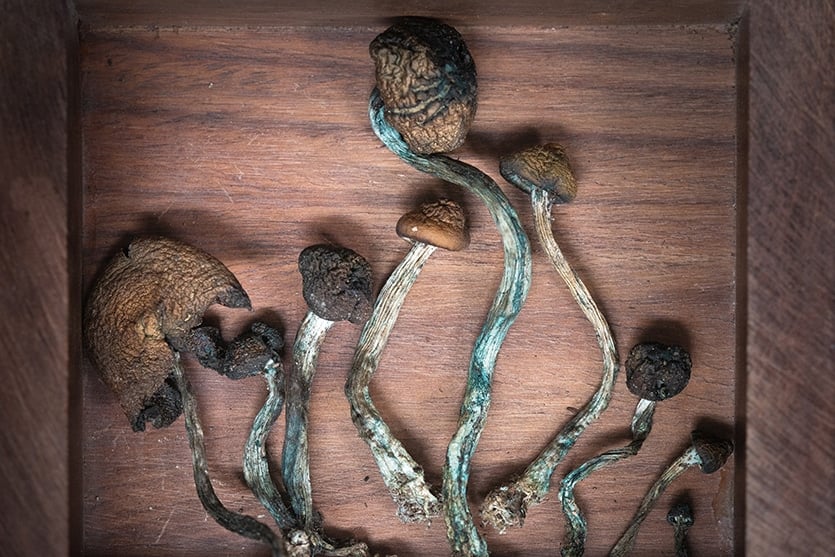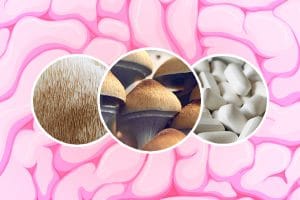Humans have been eating little brown mushrooms for millennia—and indulging in the psychedelic experiences that sometimes result. Perhaps for just as long, people have been coming up with words for these experiences, fungi and feelings. Every culture has its own vernacular for magic mushrooms and the experiences they induce. In this article, get caught up on key terms in the popular shroom slang lexicon, from magic mushrooms to integration.
The Beginnings of Shroom Slang
It was Life Magazine that introduced the words “Magic Mushroom” into the Western lexicon. In 1957 the magazine published an article written by Gordon Wasson, the vice president of J.P. Morgan & Company and amateur mycologist. Two years earlier, in 1955, Wasson traveled to Oaxaca, Mexico and attended a velada (ceremony) hosted by María Sabina, a Mazatec curandera. Wasson consumed psilocybin-containing mushrooms during the velada. He later wrote about his experience with Sabina in a Life Magazine photo essay, entitled “Seeking the Magic Mushroom.”
And thus, psychoactive mushrooms were given their first pop-culture name by Westerners. This new term sparked the beginAnd thus, psychoactive mushrooms were given their first pop-culture name by Westerners. This new term sparked the beginning of a language around the fungi distinct from the poetry, prayers, and cultural understandings that contextualized the mushrooms prior to Wasson’s arrival in Mexico. Yet, giving the mushrooms their popular name was not the only consequence of the publicity: Wasson’s article, along with other published interviews with Wasson’s wife, Valentina Wasson, sparked an influx of trip-seeking tourists to Oaxaca and drew worldwide attention to the ceremonial fungi—forever changing the region. Today, “Magic Mushrooms” is still the most commonly used name for psilocybin mushrooms in English.

The Many Names of Magic Mushrooms
There are over 200 species of mushroom that contain psychedelic chemicals including 180 that specifically have psilocybin or psilocin—each one has its own unique Latin name. Mycologists use Latin to not only name different mushrooms but to categorize them as well. The scientific name for the most common magic mushroom is Psilocybe cubensis, which is one of the mushrooms that Sabina gave to Wasson during their velada. This particular mushroom belongs to the genus Psilocybe, the genus which includes the greatest amount of psychedelic mushrooms. The term “cubensis” indicates the exact species; there are at least 245 distinct species in the psilocybe genus, and not all of them contain the psychedelic compound, psilocybin.
Yet, no matter the species, all psychedelic mushrooms are lumped together under the umbrella of “Magic Mushrooms” in Western popular culture. But, that’s certainly not the only slang term for these psychedelic fungi. Other slang for mushrooms include:
- Shrooms
- Mushies
- Caps
- Boomers
- Pizza toppings
And of course, different magic mushroom species have their own nicknames as well—Golden Caps, Blue Meanies, Penis Envy, to name a few.
Read: The Difinitive History of Psilocybin and Magic Mushrooms
Shroom Trip Slang
What is an experience without the words to describe it? Psychonauts have their own language for describing the psychedelic landscape. Shroom slang follows similar patterns to other words that have popped up around other psychedelics, like LSD and DMT. Yet, while the terms might be similar, the actual experiences of those labels can vary widely between drugs. When it comes to magic mushrooms, here are a few words worth knowing:
How to Grow Shrooms Bundle
Take Both of Our Courses and Save $90!
Tripping
Tripping is a catch-all term for the feelings, experiences, visuals, or hallucinations that occur after taking a psychedelic drug like LSD or mushrooms. It has been called a ‘trip’ since the late 1920s and really came into popularity around the psychedelic explosion in the 1960s. There are even reports of the word tripping being used by the U.S. Army experimenting with psychedelics in training.
It is called a trip because psychonauts feel like the drugs transport them to a different place, plane, state, or setting in their mind; like going on a long journey and returning to reality when the drug wears off.
Flipping
Flipping is a slang term used for mixing a psychedelic with MDMA. The term is not usually used on its own but in conjunction with other slang terms to identify the psychedelic. Hippie Flipping is using psilocybin mushrooms with MDMA, Candyflipping is mixing LSD with MDMA, and Kitty Flipping is mixing MDMA with Ketamine—all risky endeavors. The more substances added to a psychedelic cocktail, the greater the risk of unwanted drug interactions, which can be fatal in some circumstances.

Visuals
Visuals is another term commonly used across all psychedelic experiences. Visuals are the reality distortions and hallucinations experienced through your visual—and cognitive—senses after a psychedelic dosage. These can include subtle changes like the swaying of stationary trees and vibrate saturated colors. They can even include the shapes and patterns seen even when your eyes are closed. Psilocybin visuals have been described as more an augmentation of reality, where the edges of objects start to blur, move or shift. They are usually more subtle than the visual hallucinations of other psychedelics like LSD at similar dosages.
Ego Death
Ego Death is the complete loss of subjective self-identity. It is a dissolution of a person’s sense of self; body and mind. This unique experience is related to the “mystical-type” experiences that psilocybin mushrooms can occasion. Yet, a person usually has to take a very large dose of magic mushrooms to achieve this effect.
While the loss of self may sound frightening, that’s not necessarily the case; ego death can feel like a ‘oneness’ with the universe. It can be calming and help someone feel more connected to the world around them: More at peace with difficult emotions. This kind of ego death is coined “positive” dissolution, and it’s what many psychonauts seek from their magic mushroom trip. Not all ego death is positive, however. Negative ego dissolution occurs when anxiety, loss of control, and other difficult emotions accompany a loss of identity.
Bad Trip
Not all journeys follow a smooth road. Like all psychedelics, psilocybin can sometimes precipitate a bad trip, a frightening and uncomfortable experience triggered by the drug. Consumers may feel intense anxiety during a bad trip. They may also experience feelings of fear, panic, and disorientation. For more information on navigating a bad trip, read our article here.
Shroom Stomach
Shroom stomach is a specific, non-psychological, symptom of consuming mushrooms. Nausea, cramps, other stomach pains, and sometimes vomiting are among the most common side effects of magic mushrooms. Many people experience a shroom stomach within 20 to 40 minutes after eating magic mushrooms, as the fungi make their way through the intestinal tract. Raw mushrooms have tough cell walls that are indigestible to humans and this is what causes shroom stomach. There are many alternative methods of consuming mushrooms that may combat shroom stomach, including mushroom tea, mushroom chocolates, and many others. Cooking the mushrooms, grinding them into a powder, or mixing them with other foods make the fungi easier to digest.
Shroom Dosage Slang
If you’re new to psychedelics and not familiar with shroom slang, you’ll likely come across some unfamiliar terms in regard to dosage. We won’t go into the full details on dosing in this particular article, but there are a couple of terms worth knowing:
Heroic Dose
Terence McKenna coined the term “heroic dose” for his recommended dosage of mushrooms for those wanting to have an intense psilocybin experience. When he first came up with the term it was associated with five grams of raw mushrooms. These days a heroic dose is used more colloquially for a very large dose of any psychedelic that causes intense hallucinations and induces reactions like ego death.

Microdose
A microdose is the opposite of a heroic dose. Instead of trying to take the largest dose of a psychedelic and go deep inside the experience, microdosing is about taking an extremely small, almost imperceptible dose and continuing to go about your daily life. It usually ends up being between one-20th to one-tenth of a recreational dose. For mushrooms, that’s about 0.1 grams. Microdosing has been anecdotally shown to help with depression, anxiety, socializing, creativity and productivity.
Words To Know for Safer Tripping
Knowing the language can’t guarantee a safe and rewarding trip but it can help you be informed and know what to look for before starting a psychedelic journey. Here are a few concepts worth knowing before you dive into the magic mushrooms experience:
Set and Setting
Set and setting were created by Timothy Leary in his 1965 book on psychedelics. Set is your mindset; your internal state before and during a psychedelic experience. Your emotions, mental health, mood, personality, perceptions, and beliefs can drastically affect how the drugs present during your psychedelic experience. Setting is everything external during a psychedelic trip; the people you are around, the location, the music, the weather—your environment. This can also have an outsized impact on how your psychedelic experience manifests. It is crucial to ensure that both your set and setting are right before taking psilocybin. And “right” is a personal guide point that only you can really distinguish.
Read: How To Survive A Bad Trip
Navigation is the term used to describe how you mentally travel through your psychedelic trip. What is your intention for the experience? What is going on in your mind at different stages of the trip? How do you talk to yourself and what are you thinking about? If a negative experience arises, can you recognize it for what it is and move through it? Navigation about the journey you are taking and how you are moving through it.
Integration
Integration is the last step in a psychedelic journey. Integration should usually happen a few days after a psychedelic trip. It is taking some time either by yourself, with friends, or with a therapist to digest the trip and make sense of it. You are using your conscious mind to unpack and understand what happened while your mind was in a different state and how you can apply that to your life when you are not under psychedelics. Integration is particularly important for people using psychedelics to heal from trauma, yet it is also important after a recreational dose. Integration is creating space to make meaning of that experience.
Knowing a few shroom slang words or two will help you interpret and understand the science, culture, and experiences around psilocybin. Always be careful with sourcing, dosing, and testing mushrooms. Although there is never a completely risk-free way to experiment with psilocybin, understanding the lingo can help.
How to Grow Shrooms Bundle
Take Both of Our Courses and Save $90!

DoubleBlind is a trusted resource for news, evidence-based education, and reporting on psychedelics. We work with leading medical professionals, scientific researchers, journalists, mycologists, indigenous stewards, and cultural pioneers. Read about our editorial policy and fact-checking process here.

DoubleBlind Magazine does not encourage or condone any illegal activities, including but not limited to the use of illegal substances. We do not provide mental health, clinical, or medical services. We are not a substitute for medical, psychological, or psychiatric diagnosis, treatment, or advice. If you are in a crisis or if you or any other person may be in danger or experiencing a mental health emergency, immediately call 911 or your local emergency resources. If you are considering suicide, please call 988 to connect with the National Suicide Prevention Lifeline.



